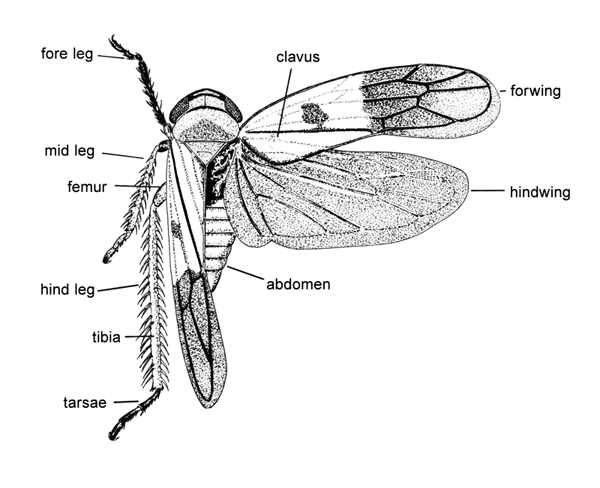Enable JavaScript for full functionality

BIOTIR 4
Sharpshooter Leafhoppers
(Hemiptera: Cicadellinae)
An Illustrated Checklist
Part 1: Old World Cicadellini
Hardcover - 232 pages - Full colour throughout
£50.00 (plus P & P)
ORDER
Biology & Ecology
Generalised morphological features of leafhoppers (Cicadellidae)


Morphological features of planthoppers (eg Delphacidae)


Morphological features of psyllids Top of page
Most species appear to be narrowly restricted in their feeding preferences, either to one or two species, or a genus of plants. Some subfamilies of Cicadellidae and many Delphacidae seem to be confined to feeding on species of Poaceae. Perhaps as few as 1% of the known species are pests of crop plants where their host range interacts with plants used for food. Sometimes it is clear that a wider range of hosts are utilised as feeding hosts than those on which nymphal development takes place. The majority of leafhopper species feed from phloem tissue, while some feed from xylem tissue and others from the contents of mesophyll cells. As far as is known most planthoppers feed from phloem tissue, but several families seem to feed as nymphs from fungal hyphae, especially those of the family Derbidae, species of which are frequently abundant in the tropics.
Eggs of most species are laid directly into the tissue of the host plant by the adult female, using it’s piercing ovipositor. All species appear to have 5 nymphal instars, in which the progressive development of wing pads is observed, before the final moult into the winged adult stage. Some species have short forewings and an absence of hindwings, and are unable to fly. Other species may have fully developed wings but under certain environmental conditions develop short-winged forms. The nymphal stage of cixiid planthoppers takes place underground, where feeding is thought to occur from roots. Adults are free-living and may feed from a wide range of plants e.g Myndus crudus, the putative vector of coconut lethal yellowing, feeds on a range of grass species as nymphs but feeds from a wide range of palms as adults. Mating takes place on the palm host plant and eggs are laid at the base of grasses.
Top of pageMany species of leafhoppers and also many delphacid planthoppers, may have different wing forms as adults. Adults may be either long-winged (macropterous, or dispersal forms, with fully developed flying wings) or short-winged (brachypterous, adult wings not functional for flying) within a single population of a species. Some species also have sub-macropterous specimens. The proportion of long-winged and short-winged forms in planthopper populations may vary considerably based on the species involved and population density. For species that tend to be short-winged, crowding (or poor host plant quality) will cause nymphs to develop into long-winged (dispersal) forms.
Prokelisia marginata
Some species disperse and migrate long distances, which is well documented for the brown rice planthopper, Nilaparvata lugens, a major rice pest, whic migrates from tropical southern China north to Japan in large numbers. Some other species are specialised to breed on rapidly colonising and perhaps ephemeral plants and then disperse. Populations of individual species may be highly variable from one year to the next season. Some species may be less common in successional habitats than they are in ecologically stable habitats. Short-winged leafhoppers and planthoppers may occur inhabitats that are maintained in a similar condition for a long period of time.



